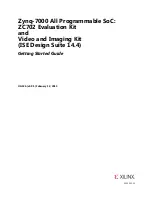...the world's most energy friendly microcontrollers
2014-07-02 - Gecko Family - d0001_Rev1.30
27
www.silabs.com
Figure 6.2. Device Unlock
Unlocked
Cort ex
Locked
No access
AAP
Program
ex ecut ion
Reset
150 us
47 us
No access
AAP
Program
ex ecut ion
If the device is locked, it can be unlocked by writing a valid key to the AAP_CMDKEY register and then
setting the DEVICEERASE bit of the AAP_CMD register via the debug interface. The commands are not
executed before AAP_CMDKEY is invalidated, so this register should be cleared to to start the erase
operation. This operation erases the main block of flash, all lock bits are reset and debug access through
the AHB-AP is enabled. The operation takes 40 ms to complete. Note that the SRAM contents will also
be deleted during a device erase, while the UD-page is not erased.
Even if the device is not locked, the can device can be erased through the AAP, using the above
procedure during the AAP window. This can be useful if the device has been programmed with code that,
e.g., disables the debug interface pins on start-up, or does something else that prevents communication
with a debugger.
If the device is locked, the debugger may read the status from the AAP_STATUS register. When the
ERASEBUSY bit is set low after DEVICEERASE of the AAP_CMD register is set, the debugger may
set the SYSRESETREQ bit in the AAP_CMD register. After reset, the debugger may resume a normal
debug session through the AHB-AP. If the device is not locked, the device erase starts when the AAP
window closes, so it is not possible to poll the status.
Summary of Contents for EFM32G
Page 505: ......


















